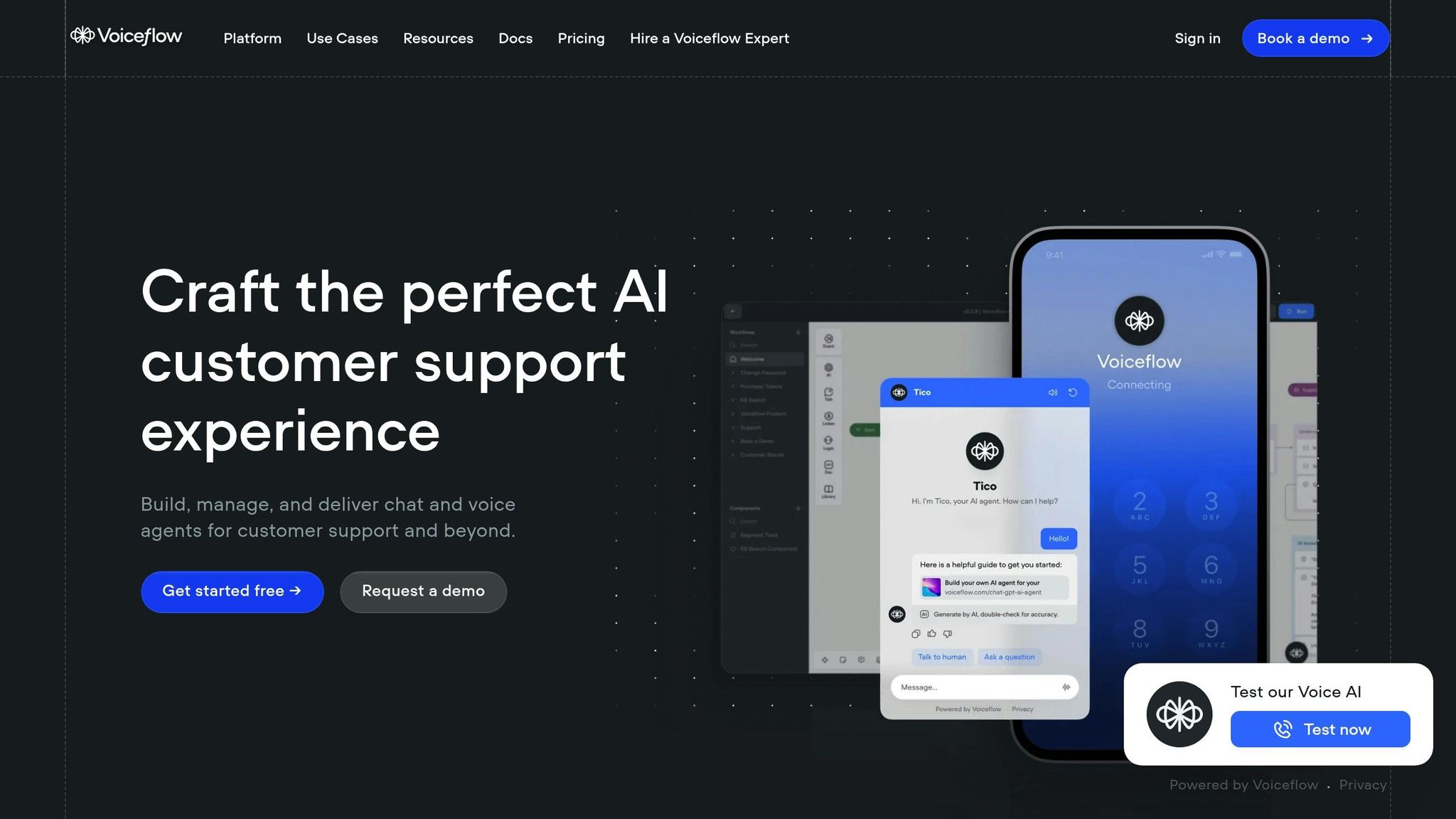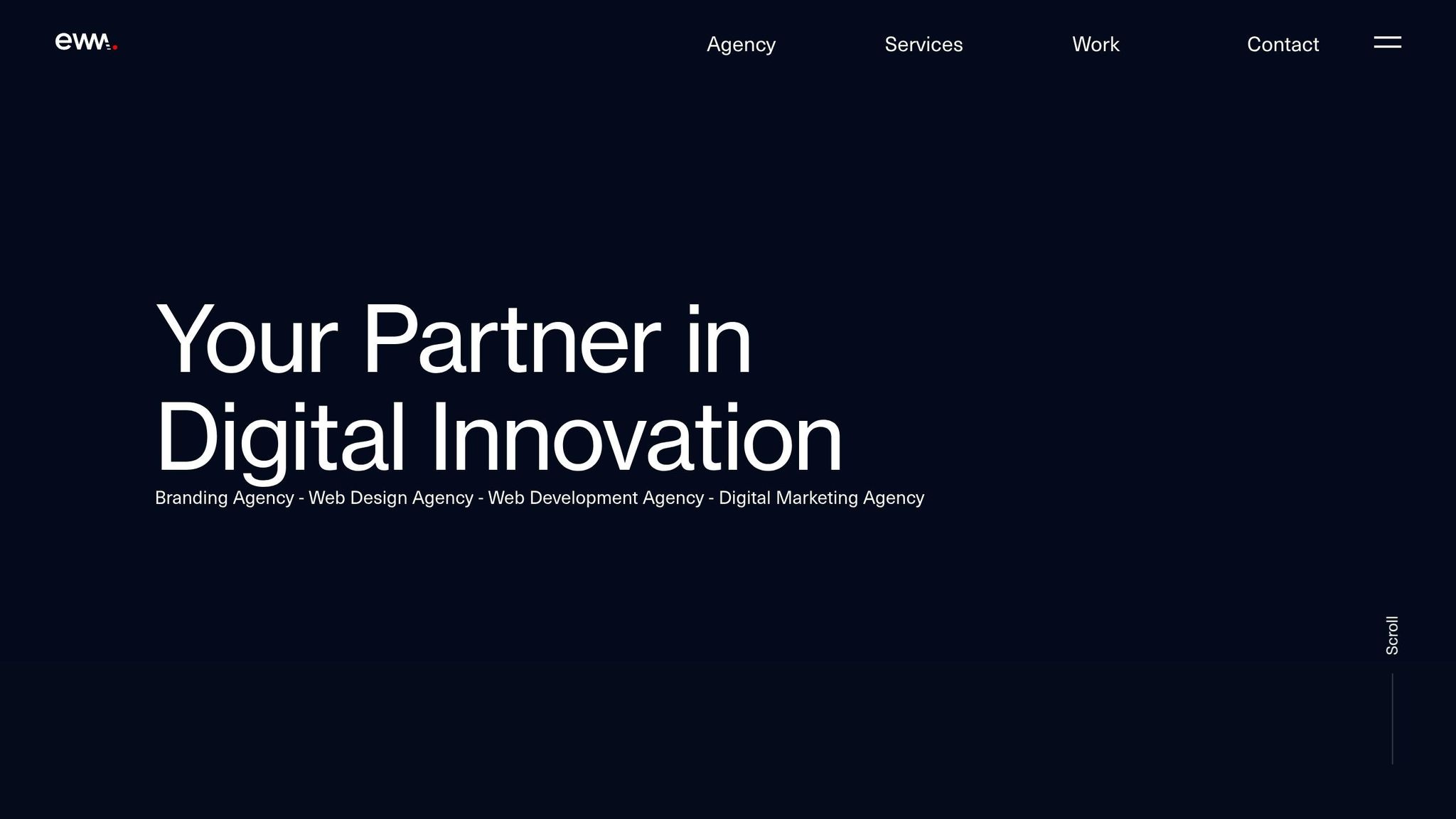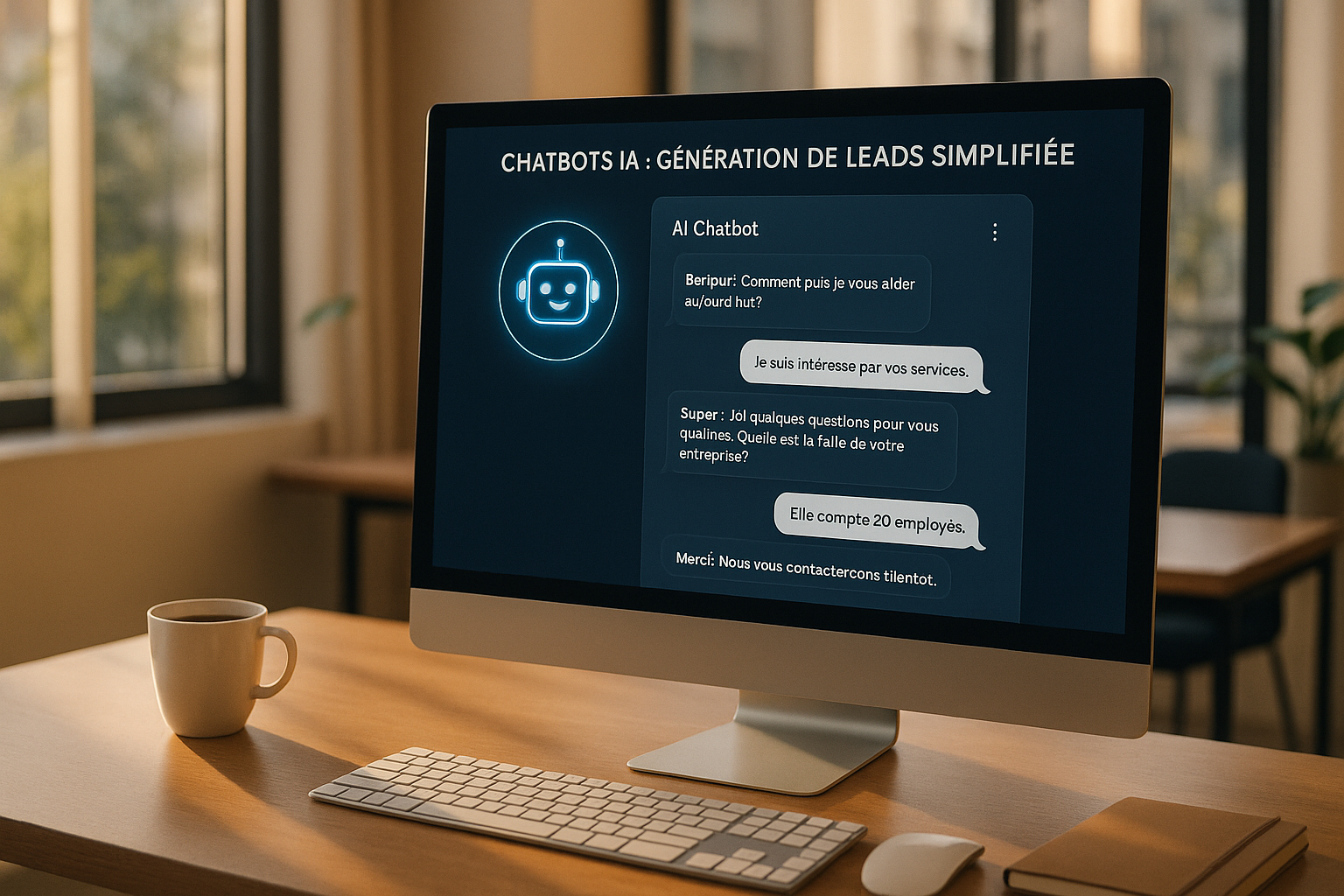Chatbots AI: Lead Generation Simplified
Chatbots AI: Simplified Lead Generation
AI chatbots are transforming the way Swiss companies generate and qualify their leads. Available 24/7, capable of handling multiple national languages (French, German, Italian, and English), these tools automate initial interactions with prospects, reduce operational costs, and increase conversion rates. For example, companies like Teleboy have seen 71% of customer inquiries handled automatically.
Key Points to Remember:
- Time-saving: Automation of initial interactions and instant lead qualification.
- Cost reduction: Up to 30% savings compared to traditional processes.
- Proven efficiency: Average 25% increase in lead qualification rate.
- Legal compliance: Compliance with Swiss regulations and standards (FADP).
- Multilingual advantages: Adapted to the Swiss market with management of the four national languages.
AI chatbots do not replace human teams but complement them by allowing them to focus on high-value tasks, such as closing sales. However, their implementation requires careful planning, integration with CRMs, and special attention to data security.
How to Build an AI Lead Generation Chatbot using Voiceflow

How AI Chatbots Work for Lead Generation
AI chatbots simplify and automate lead capture and qualification, offering a seamless and efficient experience for Swiss companies.
Natural Language Processing for Customer Conversations
Natural Language Processing (NLP) is at the core of modern AI chatbots. With this technology, they can understand, interpret, and analyze human language to provide tailored responses. Unlike old rule-based models, these chatbots use NLP and machine learning to engage in conversations that mimic human exchanges.
They rely on Natural Language Understanding (NLU) to decode user intentions, even in case of errors or inaccuracies. These tools associate user inputs with specific intentions to generate relevant responses.
This capability is particularly useful in Switzerland, a multilingual country, where chatbots can analyze user emotions and adjust their responses accordingly. Recent advances in NLP have enhanced the accuracy and fluidity of interactions.
An illustrative example: Hello Sugar, a waxing and sugaring salon based in the United States, saves 14,000 CHF per month by automating 66% of customer inquiries.
Lead Qualification and Data Collection
AI chatbots qualify prospects by engaging in targeted conversations, asking specific questions about needs, budget, or user timelines. They follow predefined flows to guide visitors through the qualification steps.
This process relies on a lead scoring system, based on criteria such as budget, needs, or decision-making authority. All collected data is directly integrated into CRMs, providing a structured foundation for sales teams.
The results speak for themselves: these AI assistants can convert up to 28% of site visitors into qualified leads, with a conversion rate three times higher than traditional forms. For example, Intercom deployed a qualification bot that led to a 73% increase in qualified leads, a 50% reduction in initial qualification time, and a 33% increase in conversions to paying customers.
In addition to their effectiveness, these chatbots operate continuously, optimizing each interaction.
24/7 Availability and Multi-User Support
One of the major advantages of AI chatbots is their continuous availability. These bots instantly respond to customers, regardless of the time or day, a valuable asset for Swiss companies interacting with clients in multiple time zones.
With their ability to handle an unlimited number of conversations simultaneously, they ensure personalized attention to each prospect, without the limitations of human teams.
The numbers confirm their impact: 69% of customers say they would use a chatbot to resolve their issues more quickly. Companies see a 55% increase in quality leads, and in some sectors, conversion rates reach up to 70%.
A concrete example: H&M, which integrated an AI chatbot on its website and social media, saw engagement increase by 30% and conversion rates rise by 15%.
As Chris Huggins, Head of Conversational Commerce, points out: "We use conversational AI and AI to drive digital innovation and facilitate our customers' purchasing journey - it's something extraordinary."
Step-by-Step Guide to Setting Up AI Chatbots for Lead Generation
AI chatbots have proven their effectiveness in lead generation. Here's how to configure them to maximize their potential.
Defining Target Audiences and Lead Qualification Rules
Start by identifying your Ideal Customer Profile (ICP). Analyze commonalities among your best customers: company size, industry sector, decision-makers involved, specific needs. Then, define specific criteria, such as visiting the pricing page, downloading a case study, or requesting a demo, and assign scores to prioritize the most promising leads.
A concrete example: MongoDB integrated Drift's chatbot into its strategy. The result? A 70% increase in new leads and a doubling of messaging responses.
To further personalize interactions, focus on segmentation. Here are three main approaches:
| Segmentation Strategy | Description |
|---|---|
| Behavioral Segmentation | Analysis of visitor interactions with your site or chatbot to understand their interests |
| Demographic Segmentation | Classification of leads based on criteria such as age, location, or job position |
| Firmographic Segmentation | Organization of leads based on company size, sector, or revenue |
This segmentation enhances the performance of chatbots, already known for their speed and accuracy in lead qualification.
"The most expensive thing you can do in sales is spend your time with the wrong prospect." - Jeb Blount, Sales Gravy
Creating Multilingual Conversation Flows
In a multilingual country like Switzerland, a chatbot must be able to handle multiple languages. Determine the necessary languages (French, German, Italian, English) and use a platform capable of automatically detecting the language and translating in real-time.
Prepare scripts and FAQs tailored to each language. To ensure their relevance, collaborate with native speakers and local experts. This helps reflect cultural specificities and regional expectations.
Also, create style guides for each language to ensure consistency in tone and terminology. Adapt chatbot responses to local regulations, holidays, and Swiss market peculiarities. Finally, regularly test performance with native speakers to identify possible improvements.
Connecting with CRM and Ensuring Data Protection Compliance
Once personalized interactions are in place, integrate the chatbot with your CRM to centralize and leverage data effectively. Ensure data hosting in Switzerland to comply with FADP and GDPR. On May 8, 2025, the Federal Data Protection and Transparency Commissioner (FDPIC) reminded that the FADP directly applies to AI systems processing personal data.
For high-risk projects, a Data Protection Impact Assessment (DPIA) is mandatory.
"Your data remains your data. We ensure it stays secure - on Swiss soil, with Swiss standards." - EagleGPT
Data security is crucial, especially in sensitive sectors like finance or healthcare.
Testing, Monitoring, and Improving Performance
Simulate real scenarios to identify chatbot weaknesses and correct them promptly. Track key indicators such as conversion rate, lead quality, response time, and user satisfaction. These data indicate what works and what needs adjustments.
Continuous improvement relies on conversation analysis. Identify obstacles, adjust qualification criteria, and update chatbot training based on feedback and market trends.
Train your teams to ensure optimal and secure use of the AI chatbot. Also, monitor regulatory developments in Switzerland to remain compliant with data protection and AI laws.
Advantages and Disadvantages of AI Chatbots
After seeing how AI chatbots work and are configured, let's look at their main strengths and limitations. These tools facilitate lead generation but come with challenges.
Advantages: Availability, Savings, and Multilingual Management
Thanks to their 24/7 availability, chatbots can interact with prospects at any time, even outside regular hours. This is a major asset for Swiss companies dealing with clients across different time zones.
In terms of costs, chatbots offer an economical solution. An interaction via chatbot costs around 0.50 CHF, compared to 5 to 12 CHF for a human agent. This allows Swiss SMEs to reduce expenses while maintaining quality service.
Multilingual support is another essential advantage, especially in a country like Switzerland. Chatbots can handle multiple languages such as French, German, Italian, and English, increasing conversion opportunities.
Finally, chatbots enable valuable data collection. Each interaction generates useful information to analyze user behaviors and adjust strategies.
Disadvantages: Technical Limits and Acceptance Challenges
One of the main obstacles is handling complex queries. Chatbots often struggle with ambiguous or very specific questions, which can lead to inaccurate or unsatisfactory responses. In reality, only 30% of issues are resolved without human intervention.
Security issues are also concerning, especially in Switzerland, where data protection is strictly regulated. Chatbots, handling sensitive information, can become targets for cyberattacks. Meeting FADP and GDPR requirements requires rigorous security measures, such as local data hosting.
Lack of empathy is another weakness. Chatbots are not designed to handle emotionally complex situations or calm frustrated customers, which can harm a company's image.
Additionally, the initial costs to set up a chatbot can be high, especially for small businesses. This includes training, integration with existing systems, and customization, representing a significant investment.
Finally, customer acceptance remains a challenge. For example, 23% of American adults find chatbots boring or ineffective, and only half of consumers prefer to interact with them.
"Perhaps the most human thing we can instill in our chatbots is the knowledge of their own limitations. In other words, bots should know when to seek help from a human agent." - IBM
These challenges underscore the importance of careful planning and thoughtful implementation to overcome obstacles.
Comparative Table: Advantages vs. Disadvantages
| Advantages | Disadvantages |
|---|---|
| 24/7 Availability - Continuous Interactions | Limited Management - 30% of cases require human intervention |
| Reduced Costs - 0.50 CHF per interaction | High Initial Costs - Investment in training and integration |
| Multilingual Support - Ideal for the Swiss market | Security - Risks related to sensitive data |
| Data Analysis - | Lack of Empathy - Sometimes inadequate responses |
| Ability to Handle Large Volumes | Customer Resistance - Some find chatbots ineffective |
In summary, while AI chatbots offer undeniable advantages, their success relies on careful preparation and implementation tailored to the specific needs of the company.
Best Practices for Success with AI Chatbots
To maximize lead qualification through an AI chatbot, it is essential to adapt it to local specificities. These recommendations are part of a comprehensive strategy to optimize lead generation through these tools.
Personalization for Swiss Audiences
Linguistic and cultural personalization plays a key role in the effectiveness of a chatbot in Switzerland. This country, with its multiple official languages, stands out for the frequent mixing of languages in a single conversation. The dialogue manager must be able to handle these transitions while maintaining context.
For this:
- Enable automatic language detection via browser settings so that the chatbot instantly adapts to the prospect's language.
- Set up specific glossaries to ensure consistent terminology that reflects your brand image.
- Prefer a solution integrated with automatic translation tools, rather than training a separate chatbot for each language. This helps reduce maintenance and development costs.
Compliance with Swiss Legal and Data Standards
Compliance with Swiss legislation is imperative. The FADP (Federal Act on Data Protection) imposes strict rules regarding the processing of personal data by AI, especially in terms of transparency on purpose, operation, and data sources.
"The FDPIC emphasized, in particular, the requirement for transparency regarding the purpose, functionality, and data sources of personal data processing based on AI."
Your chatbot must adhere to the principles of proportionality, purpose limitation, and data security, in accordance with Articles 6 and 8 of the FADP. Additionally, Article 21 requires informing users if an automated decision has significant legal implications.
A notable aspect of Swiss regulation: fines, up to 250,000 CHF, are imposed on responsible individuals, not companies. To avoid any risk, integrate transparent mechanisms following Privacy by Design and Privacy by Default principles from the outset.
Collaborating with the Expertise of

Partnering with a specialized agency like EWM SA can provide a decisive advantage. Based in Geneva since 2011, this digital agency has an in-depth understanding of the Swiss market specificities and the technical challenges of multilingual solutions.
EWM SA offers a comprehensive approach focused on humans, ensuring perfectly integrated chatbots that comply with local requirements. The agency excels in complex integrations, connecting your chatbot to your CRM and marketing automation tools.
With offices in Geneva, Zurich, Paris, London, and Nice, EWM SA masters the cultural and regulatory subtleties of each market. Their expertise in bilingual SEO and localized content enhances the lead generation capabilities of your chatbot.
By collaborating with seasoned experts, you benefit from tested and optimized processes to inform users of the
